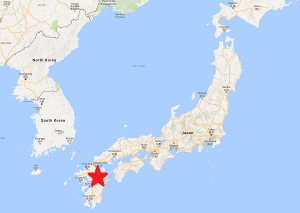
Mount Aso, the largest active volcano in Japan, erupted hours ago, sending a column of ash and smoke nearly 7 miles into the air, according to the Japan Meteorological Agency. The volcano is located in the Kumamoto Prefecture on the southwestern island of Kyushu; prior to today’s eruption, the volcano stood at about 5,200 feet tall.
The Japan Meteorological Agency raised the Volcano Alert area to a Level 3, with 5 being the highest level. “It is extremely rare for an eruption column to exceed 10,000 meters (32,500 feet / 6.5 miles) ,” Makoto Saito, director of the agency’s Volcanology Division, told TV Asahi on Saturday. Saito added that while the volcano is in its active phase, there is a “possibility” another eruption of the same scale could occur.
The FAA reports that the ash cloud is forecast to rise further and impact United States and Asian trans-Pacific flights between Tokyo and major North American airports, including Honolulu, Vancouver, Seattle, San Francisco, and Dallas-Fort Worth.
Volcanic ash and air travel don’t mix. Ash is heavy enough to make it difficult to see out of a cockpit window and could make sensors, such as RADAR, malfunction due to its density, rendering pilots “blind.” Worse, volcanic ash can clog engines. According to Boeing, volcanic ash can accumulate in jet engines, leading to equipment failures. Volcanic ash is also high in silica, the basic ingredient of glass. The high temperatures of jet engines can melt volcanic ash into glass, glazing the engine with glass. When encased in glass, experts believe exhaust from the engines would back up into the aircraft, filling the cabin with toxic gas. Because of these risks, airlines and the government agencies that regulate them keep airplanes far away from high-altitude ash clouds, such as the one from Mount Aso.
It is hard to predict how much more ash will be pumped into the atmosphere from Mount Aso or if subsequent explosions will put ash as high as this morning’s eruption did. As a result, there is uncertainty with what lingering impacts to air travel will be or how long they’ll last. If you’re planning to travel across the Pacific to/from Japan and the United States, or have other trans-Pacific journeys planned that would bring a jet in the vicinity of this ash cloud, you are encouraged to contact your airline before you travel to see if your air travel plans are impacted.